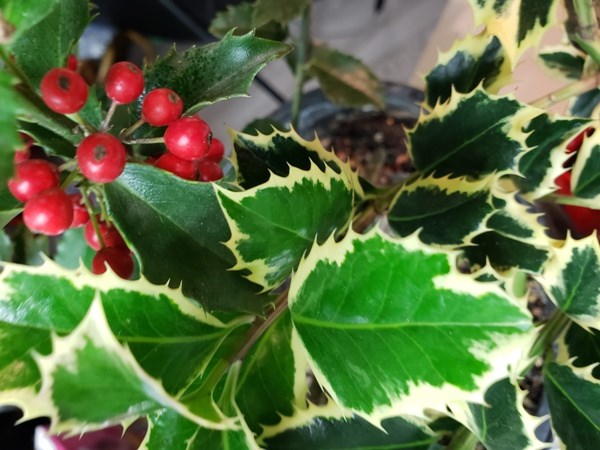The Ilex, or holly, is a genus that is widespread throughout the temperate and subtropical regions of the world. It includes species of trees, shrubs and climbers, some with evergreen and some with deciduous foliage. It also is found from sea level to more than 2,000 metres as some of the species are happiest in higher mountainous areas. The family is Aquifoliaceae and the Ilex genus is the only living genus in this family.
The plants themselves are relatively slow growing, have simple, alternate leaves that often have a spiny leaf margin. Flowers are inconspicuous, greenish white in colour with four petals. They are generally dioecious, with male and female flowers on different plants. The fruit, although it looks like a berry, is actually a drupe and will range in colour from red, to brown to black with some fruit that is green or yellow. It is toxic to humans but used as a food source by many birds and animals. Some will retain their fruit and ripen in winter to provide great winter colour. Nellie R. Stevens is a common cultivar grown for its glossy green leaves and brightly coloured fruit. At this time of year, we often see branches of I. aquifolium in florist shops as they make great Christmas décor. Along the west coast of North America, we see this introduced species spreading into native habitat and is being monitored or registered as an invasive plant depending on the region.��
Holly is, of course, also a plant that is referenced throughout history and especially around Christmas time. To Christians it often is referred to by the name Christ’s thorn and is expressed in the traditional Christmas carol “The Holly and the Ivy” where the holly represents Jesus and the ivy represents the Virgin Mary. Holly also has significance in many other beliefs. The Druids believed the leaves of holly offered protection against evil spirits and thus wore holly in their hair. In the Harry Potter novels, holly is used as the wood in Harry’s wand. In some traditions of Wicca, the Holly King is one of the faces of the Sun God.
If you wish to grow holly in areas that are too severe for holly to survive the winter, then it must become a houseplant for the winter months. Keep it on the moist side as in our indoor environments that have low humidity it will dry out quickly. If you live in less severe areas, they do need acidic soil and will do well in both well-drained and swampy areas. If you wish to have berries remember that you will either need to plant a holly that does not need fertilization or plant both male and female plants. If you live in zones 5 to 9 then plant American holly (Ilex opaca) which is native to the �鶹��ýAVern and Eastern United States. The Croonenburg cultivar is a good choice if you are pressed for space as it will pollinate itself, having both male and female flowers on the same plant. Canary has yellow fruit.
Wishing you and yours a safe, happy and healthy holiday season. Thank you for reading these columns and if you wish to learn more about any specific topics, please drop me a line and I will happily share the knowledge. Do check out my YouTube channel GROW if you are looking to gain knowledge by watching videos.��
Hanbidge is the lead horticulturist with Orchid Horticulture. Find us at ; by email at [email protected]; on facebook @orchidhort and on instagram at #orchidhort.
��




